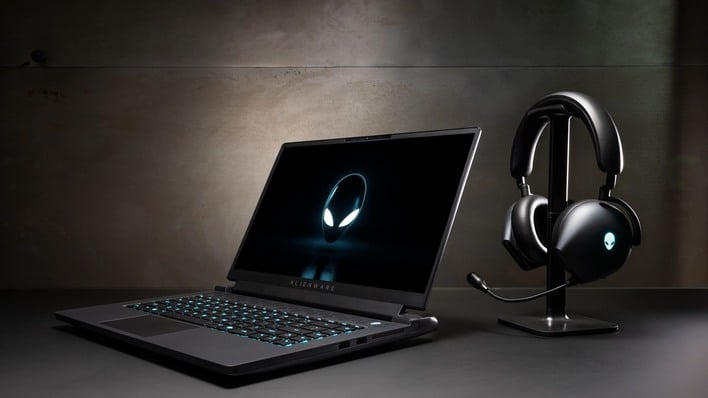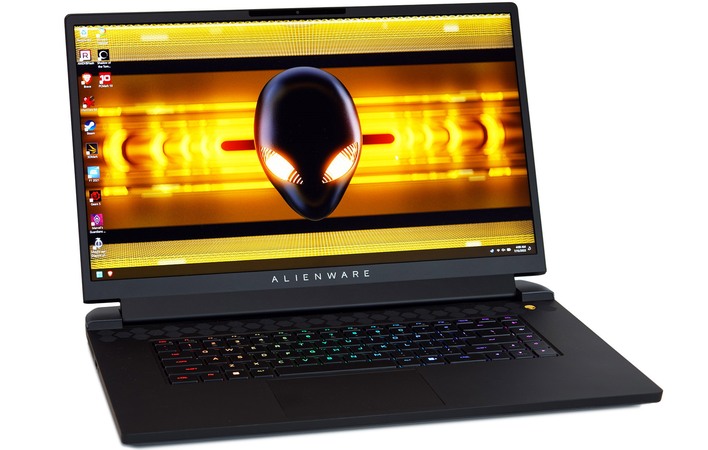Alienware m17 R5 Review: AMD Advantage Gaming Laptop Shines
Alienware m17 R5: Acoustics, Battery Life, And The Review Verdict
When idling or running mainstream applications, even with the Radeon RX 6850M XT engaged, the Alienware m17 R5 is essentially inaudible. To get it to register on our sound level meter while idling, we had to essentially shove the microphone up against the exhaust, which isn't exactly a realistic test. However, during our Prime95-and-FurMark torture test that we talked about on the previous page, the fans in the machine did spin up quite audibly.
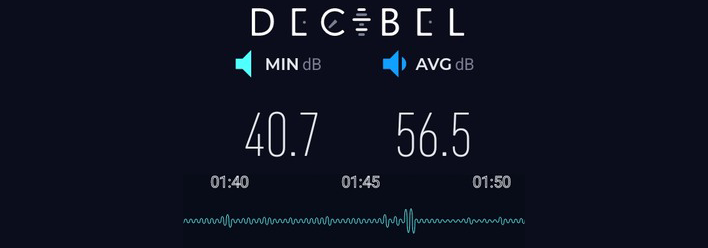
We measured a maximum sound level of 57 dB at a distance of one foot from the keyboard with the machine under load. To be clear, that's definitely audible, although the character of the fans is modest and "wooshy", with nary a hint of the high-pitched, shrill tone you sometimes hear from laptop coolers. It sounds like a larger heatsink-and-fan assembly doing a lot of cooling, which is exactly what it is.
Under normal gaming, we don't think anyone would consider the machine loud at all. The cooling apparatus on the m17 R5 is so potent that under typical gaming workloads it often doesn't even audibly spin up. Sure, it's working; copious hot air is being expelled from the chassis, but you'd never know unless you stick your hand in front of the vent. It is an impressively silent laptop outside of contrived stress tests.
Mux Ado About Something Quite Cool, Actually - The AMD Advantage
One of the defining qualities of AMD Advantage laptops is that they make use of AMD's suite of "Smart" technologies. That includes SmartAccess Memory (also known as "Resizable BAR" elsewhere), SmartAccess Graphics which we'll talk about in a moment, and SmartShift Max.
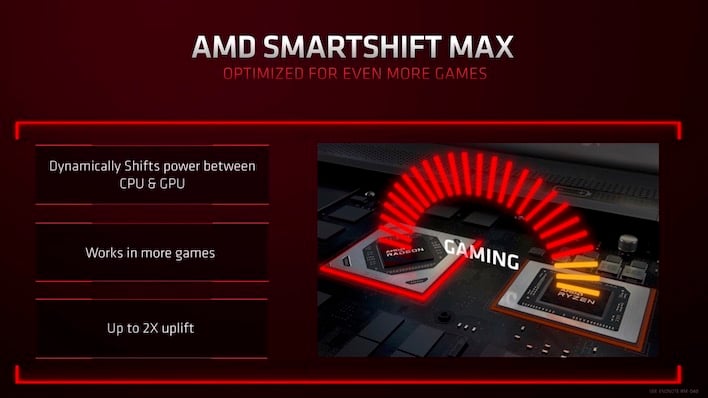
You're probably already familiar with SmartShift. In simple terms, it's an algorithm that monitors CPU and GPU usage, and can shift the balance of the power budget between the CPU and discrete GPU as needed. SmartShift Max is the revised version for the Ryzen 6000 series, and AMD says that it offers potentially double the uplift compared to the original SmartShift.
SmartShift is a difficult thing to test. There's no way to disable it—not that you'd really want to—and it's very hard to say where it is actually having an impact. You can observe its actions in the AMD software, but in our testing, we couldn't really observe a trend or pattern. Still, we do think that SmartShift is behind some of this machine's killer performance, since it effectively allows the compute engines in the system to make optimal use of the power budget.
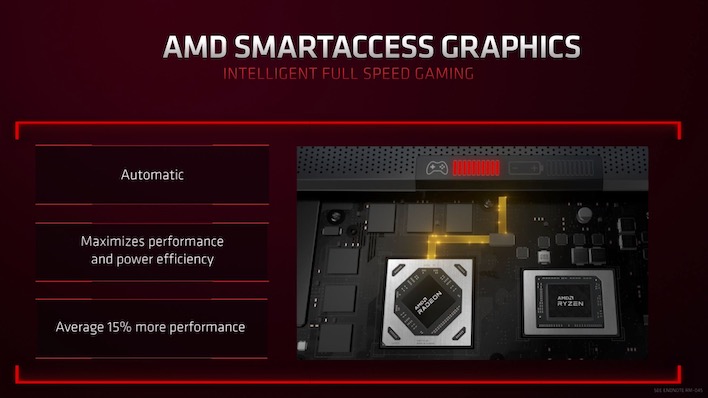
The other big smart technology that AMD and Alienware are offering on this machine is SmartAccess Graphics. This is AMD's name for its use of a mux chip between the display, discrete GPU, and integrated GPU. Traditionally, gaming laptops with switchable graphics connect the display directly to the integrated GPU and then route the discrete GPU's output through that.
That means that when the discrete GPU is finished with a frame, it has to send that frame back across the PCIe bus to the integrated GPU before it can be sent out to the display. This has a small but significant impact on both input latency and performance; AMD says it can be as much as 15%.
Using a mux with SmartAccess Graphics neatly sidesteps this issue because the mux serves like a physical switch to toggle between the displays. Switching is automatic, and it doesn't require a reboot—it happens whenever the driver thinks it should happen, and for the most part it works well.

It takes some getting used to, because when the switch happens, there's no warning as the whole system hangs up for a few moments. After that, everything's back to normal and you get the notification above in the top-right corner. (Obviously, it will say "APU to GPU" if appropriate.)
It can be jarring when it happens unexpectedly in an application like Chrome, but outside of a few weird corner cases with desktop applications that use a lot of animation or transparency effects, we didn't find it to be too troublesome, especially when considering the benefits to gaming performance. Most importantly, it never attempted to switch off the discrete GPU while gaming.
In fact, the machine is actually rather trigger-happy with the switch to the discrete GPU. We totally get it—better that than the alternative, where you end up playing a game on the integrated Radeon, which is actually fast enough that non-techie owners may not even realize what happened. However, we think that this tendency to strongly favor the discrete GPU may have had some impact on the next results.
Alienware m17 R5 Battery Life Testing
To test battery life, we use two methods primarily. First, we run a custom 1080p HD video loop test developed in-house. In all tests, Windows Focus Assist has been enabled and the displays are calibrated with lux meters on pure white screens to as close to 115 lux as possible. This typically happens somewhere in the 40-to-60% brightness range; on the m17 R5 it was right around 45%.
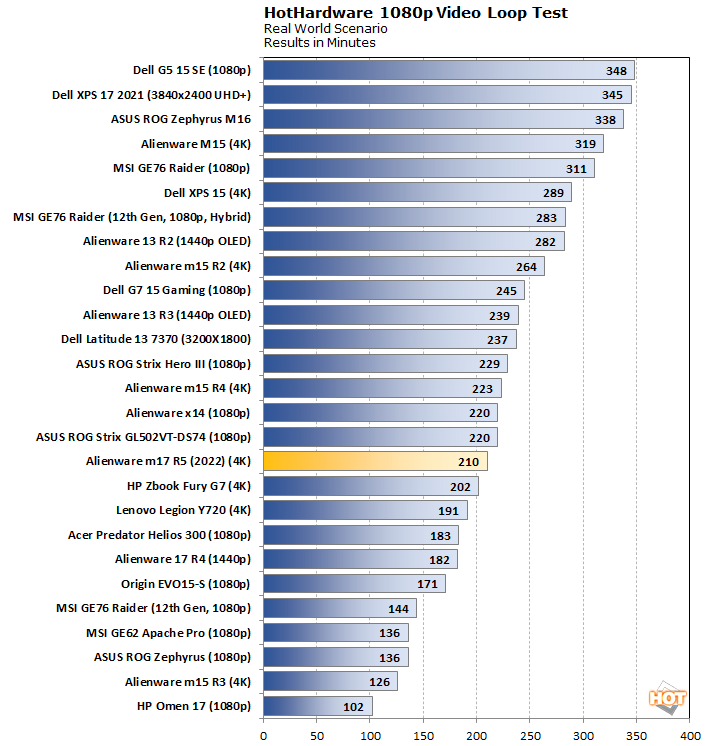
Battery life while watching videos on the Alienware m17 R5 isn't terrible, but it isn't exceptional. We clocked the system at exactly three-and-a-half hours of battery life while viewing 1080p HD video. Now, after this result, we did some investigation and found that SmartAccess Graphics does not switch to the discrete GPU during our testing—however, the GPU remained enabled, judging by its clock rate.
It's likely we could have improved this result by switching a more conservative profile in Alienware Command Center, but we do wonder how many users would make use of that function in the real world.
PCMark Battery Gaming Testing
Getting repeatable results for fair gaming battery life comparisons by hand is incredibly difficult, which is why we're grateful that PCMark 10 includes a gaming-oriented battery life test. Simply put, you charge the machine to 100%, calibrate display brightness, unhook the power, and start the test. PCMark 10 will record battery statistics and log the time at which Windows decided to shut the machine off to prevent data loss.

To be frank, this result isn't great. It's not unexpected at all, though. In fact, we don't really hold this result against the machine because with its powerful 8-core CPU and massive Radeon GPU, it's really stepping well into "desktop replacement" territory. Once again, we could probably have improved this result by changing the default power profile, but that likely would have a deleterious effect on game performance, too.
Alienware m17 R5 With AMD Advantage: The Review Verdict
The Alienware m17 R5 is the first laptop to ship with AMD's Radeon RX 6850M XT. This GPU is essentially a downclocked version of the desktop Radeon RX 6750 XT, and it performs pretty similarly to its add-in board cousin. It's a great match for the Ryzen 9 6900HX, and the combination of the two along with AMD's Smartshift Max offers superior gaming performance that is beyond reproach.
There is so much to praise about this product. The 120-Hz UHD LCD is gorgeous and vibrant, the chassis is stylish and sturdy, the slim mechanical keyboard is incredibly satisfying to type on, and even the speakers are pretty good as far as laptop speakers go. They're certainly loud enough, anyway.
Of course, the Alienware m17 R5 is not without flaws. The battery life is mediocre. The proclivity of SmartAccess Graphics to switch between the APU and GPU can be jarring at first. The keyboard layout makes the machine less suited than it otherwise might be for productivity work, and the styling is relatively understated—which we actually like, but some folks might prefer a louder gamer-centric design.
None of that meaningfully detracts from the fact that this is a legit 4K 120-Hz gaming experience that won't die in six months from constant overheating, and doesn't require dual power bricks like some machines from yesteryear. It also doesn't require hearing protection to protect your ears from piercing fan whine while gaming. The Alienware m17 R5 is a powerful gaming laptop that gets performance and cooling just right, and we have to praise it for that.
Dell asks $2,649 for this configuration of the Alienware m17 R5. That's not a small amount of money, but given what you get in exchange, we think it's a pretty reasonable package. If you compare to a system like the ROG Zephyrus G14 we just tested, this machine is much larger, sports stronger graphics and stupendous cooling, and it has a superior UHD display, all for just $150 over the asking price of that system. They're both great machines, of course, and each has their own benefits, but the point is that we think Alienware has priced the m17 R5 competitively enough for what it deliver.
So, who should buy this system? We wouldn't recommend the m17 (or any 17" laptop) to folks who are constantly on the go, like students or executive types, but that's really not what the system is meant for anyway. If you're the kind of person who wants "gaming desktop" performance, that's portable, and can't stand having a big box with wires going everywhere, this is the machine for you. It's every bit as fast as a high-midrange gaming desktop, and the price includes an excellent display, too. If you're considering a gaming notebook with a 17" form factor, the Alienware m17 R5 may be for you.

 |
 |
||
|
|

